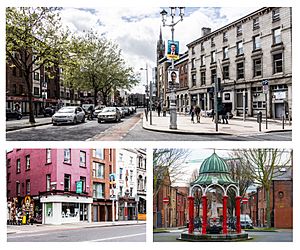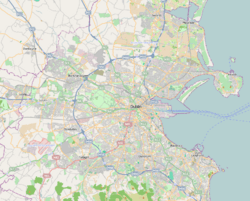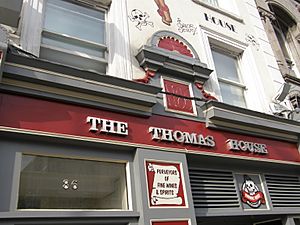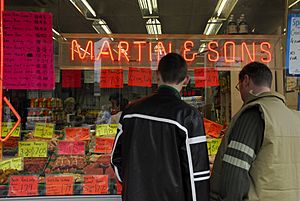The Liberties, Dublin facts for kids
Quick facts for kids
The Liberties
Na Saoirsí
|
|
|---|---|

Clockwise from top: The Cornmarket area near Thomas Street; a Reginald Street Catholic emancipation memorial that once housed a tribute to Queen Victoria; shops and bars on Thomas Street
|
|
| Country | Ireland |
| Province | Leinster |
| County | County Dublin |
| Local authority | Dublin City Council |
| LEA | South West Inner City |
| Dáil Constituency | Dublin South-Central |
| Time zone | UTC+0 (WET) |
| • Summer (DST) | UTC-1 (IST (WEST)) |
| Website | www.libertiesdublin.ie |
The Liberties (Irish: Na Saoirsí) is a historic area in central Dublin, Ireland. It is located in the southwest part of the city. This area was once made up of special lands that had their own rules, separate from the main city government. It is known as one of Dublin's oldest working-class neighbourhoods.
The Liberties has strong ties to the River Poddle and its many market traders. It is also famous for local family businesses. The area is home to the Guinness brewery and whiskey distilleries. In the past, it was a big centre for making textiles.
Contents
What does "The Liberties" mean?
The name "Liberties" comes from old legal areas. These areas were set up when the Anglo-Normans arrived in the 12th century. They were lands connected to the city but had their own special laws. This is why they were called "liberties."
The most important of these areas were the Liberty of St. Sepulchre and the Liberty of Thomas Court and Donore. The Archbishop of Dublin controlled St. Sepulchre. The Abbey of St. Thomas the Martyr controlled Thomas Court and Donore. Later, this became known as the Earl of Meath's Liberty.
Today, The Liberties area is mostly within the old borders of these two places. It is located between the River Liffey to the north and St. Patrick's Cathedral to the east.
A Look Back in Time
Early History of the Liberties
The two main liberties, Thomas Court and Donore, were mentioned in records from 1529. However, their exact locations were not fully clear then. After King Henry VIII closed down monasteries, the lands of Thomas Court and Donore were given to William Brabazon. He was an ancestor of the Earl of Meath.
In 1579, the city of Dublin tried to claim control over the abbey's land. But they lost their case. From then on, the Earl of Meath was in charge of this liberty. The Meath family gave their name to many places in the area. These include the Meath Market, the Meath Hospital, and Meath Street.
In 1728, a detailed map of Dublin was published by Charles Brooking. This map showed the boundaries of the liberties more clearly. The Manor of St. Sepulchre stretched from Bishop Street to St Stephen's Green. The Earl of Meath's liberty ran west along The Coombe to Ardee Street.
By 1837, the Ordnance Survey began making detailed maps. The Dublin map, published in 1840, showed all the liberties. It included even the smallest ones.
How the Liberties Changed Over Time
Many places in The Liberties still show signs of a difficult past. This past included political changes and great poverty. In the 17th century, some parts of the area became wealthy. This happened when Huguenot immigrants, who were skilled weavers, moved there. They found a good market for their crafts, especially around the Meath Street Market. They also had a strong export business.
Weaving and Trade in the 17th and 18th Centuries
In the late 1600s, new homes were built for the weavers moving into the area. English settlers started making wool products. Many Huguenots began weaving silk, using skills from their home country, France. They built their own style of houses, called Dutch Billies. These houses had gables facing the street. Thousands of weavers worked in areas like The Coombe and Pimlico.
However, English wool makers felt threatened by the Irish industry. So, high taxes were put on Irish wool exports. The Navigation Act stopped Ireland from selling to the colonial market. Then, in 1699, the English government passed the Wool Act. This law stopped Ireland from exporting wool anywhere. This effectively ended the wool industry in the Liberties.
A special hall for weavers was built in 1682. A new hall was built in 1745, paid for by David Digges La Touche, a Huguenot. In 1750, the weavers put up a statue of King George II on their hall. This showed their loyalty. Sadly, the hall was torn down in 1965.
In the 1700s, the industry tried to recover by importing Spanish wool. The Royal Dublin Society helped with this from 1775. But events like the 1798 rebellion and the economic problems after the Act of Union stopped any further growth. Many weavers in the Liberties took part in these uprisings.
The silk and poplin industries also grew successfully. The Royal Dublin Society supported them in the late 1700s. But a law passed in 1786 hurt this growth. It stopped the society from supporting any place that sold Irish silk goods. When war broke out with France under Napoleon, raw materials became hard to get. The silk weavers suffered a lot. The final blow came in the 1820s. The British government removed taxes on imported silk products.
From this time on, the future of the Liberties changed. Most of the once-rich houses became poor slums. They housed people who had no jobs and were very poor.
Improvements in the 19th Century
The Tenter House was built in 1815 on Cork Street. Thomas Pleasants paid for it. Before this, poor weavers in the Liberties had to stop working in rainy weather. Or they had to use pub fires to dry their cloth. This caused them great hardship. The Tenter House was a brick building, 275 feet long and three stories high. It had a heating system. This gave weavers a place to stretch their material even in bad weather.
Later, parts of the area were rebuilt. New, affordable homes and parks were created. This was done by the Iveagh Trust, the Dublin Artisans Dwellings Company, and the City Council. This happened in the early to mid-1900s. The terrible slums and poverty have now mostly been removed. Only a few small areas are left to be improved.
Culture and Arts
The Liberties has many cultural places. It is part of the larger Dublin 8 area. This area is home to five of Ireland's most popular visitor spots. The Guinness Storehouse alone gets 1.2 million visitors each year.
Thomas Street is home to the country's largest art college. This is the National College of Art and Design (NCAD). The college started in 1746 as a private drawing school. Now, it is a national school with over 1,500 students. NCAD degrees are approved by University College Dublin.
The Liberties also has several art galleries. These include the one at NCAD, and private galleries like Basic Space and Pallas Projects. The Irish Museum of Modern Art is also nearby.
Fun and Entertainment
The Liberties offers many shows in theatres, bars, and music venues. Vicar Street, on Thomas Street, hosts comedy, plays, and concerts. It can hold 1,500 people. The Thomas House is a venue known for punk, rock, and reggae music.
The Liberties Festival
The Liberties Festival is one of Ireland's oldest festivals. It began around 1970. It now includes sports and community events. It also has a wide range of arts programs. These include visual art, film, dance, comedy, literature, and music. Most events during the festival are free. The festival is supported by DCC and local businesses.
The Liberties Brewers Cup
The Liberties Brewers Cup is a yearly competition for coffee lovers. It started in 2017. Each year, 15 people compete in a black coffee brewing challenge. Spectators can watch the baristas' skills and meet other coffee fans. Food, drinks, and music from local DJs are also provided.
Economy and Business
Brewing and Distilling
The Liberties is famous for the Guinness brewery. The company Diageo continues to invest in it. For example, they spent €130 million on Brewhouse No. 4. The Guinness Storehouse is Ireland's most visited paid tourist spot. It gets 1.6 million visitors every year.
Most local breweries and distilleries closed in the late 1800s. But now, the area is becoming a centre for craft distilling and brewing again. Teelings Whiskey opened a new distillery and visitor centre in Newmarket. This was the first new Irish whiskey distillery in Dublin since the 19th century. Other companies like Dublin Whiskey Company and Alltech have also invested in the area. The Pearse Lyons distillery opened in 2017. The Beer Market, a bar that only serves beer, opened in 2015. The Dublin Liberties Distillery also makes Irish whiskeys.
Shopping and Markets
In the past, The Liberties had many market areas. Today, you can find the Liberty Market on Meath Street. There are also fruit and vegetable markets on weekends on Thomas Street and Meath Street. Street vendors are found throughout the area. There are plans to develop more market areas, like the Iveagh Market.
The Digital Hub
The Digital Hub is a group of digital content and technology companies. It is located on a campus in the middle of The Liberties. The Government of Ireland set it up in 2003. Now, The Digital Hub is home to 100 Irish and international businesses. It is Ireland's largest group of technology and digital media companies.
Improving the Business Area
The Liberties Business Area Improvement Initiative is a project to make the business heart of Dublin 8 better. Dublin City Council works with local businesses on this. They want to create a more lively and attractive neighbourhood. You can find more information on their website: http://libertiesdublin.ie.
Interesting Places to Visit
The Liberties has many famous landmarks and monuments. Some of these date back to medieval times. One of the most important is Christ Church Cathedral. This is one of Dublin's two medieval cathedrals. The other is St Patrick's Cathedral.
Christ Church Cathedral
Christ Church is the main church for the Archbishop of Dublin in the Church of Ireland. It was founded around 1030. The Normans later rebuilt it in stone after they arrived in Ireland in 1169.
Saint Patrick's Cathedral
Saint Patrick's Cathedral was founded in 1191. It is the largest church in Ireland. It is Dublin's second Church of Ireland cathedral. Today, Saint Patrick's hosts many national ceremonies. It is also a popular place for visitors. Next to the cathedral is St Patrick's Park, a public park.
Guinness Storehouse
The Guinness Storehouse is Ireland's most visited paid tourist spot. It gets 1.6 million visitors each year. It shows off the famous St. James's Gate Brewery. The Storehouse has seven floors around a glass area. This area is shaped like a pint of Guinness. On the top floor, the Gravity Bar offers views of the Liberties and Dublin city.
John's Lane Church
John's Lane Augustinian Church is on Thomas Street. It was designed by Edward Welby Pugin and opened in 1874. The 12 statues in the tower are by sculptor James Pearse. He was the father of Patrick and William Pearse. The church steeple is the tallest in the city, standing over 200 feet (61.0 m) high.
Teeling Whiskey Distillery
In summer 2015, Teeling Whiskey opened a distillery and visitor centre in Newmarket. This was the first new Irish whiskey distillery in Dublin since the 19th century. Visitors can now take guided tours and taste whiskey.
Getting Around
Roads and Buses
The Liberties has good road connections. Several main roads serve the area. The Liffey Quays are to the north. Patrick Street forms the eastern border. Cork Street runs through the south. Thomas Street is the main road through the Liberties.
Dublin Bus has many services throughout the Liberties. You can find real-time bus information at many stops.
Rail and Tram
There is no train station directly in the Liberties. However, Heuston Station is just to the north. It is one of Ireland's main transport hubs. You can use Luas (Dublin's tram system), Dublin Bus, or DublinBikes to get to the Liberties from Heuston Station.
The Luas tram system offers frequent and reliable service. The fare depends on how many zones you travel. There are two Luas lines. The Red Line has stops in the Liberties, including Rialto, Fatima, and James's.
Cycling
The Liberties is in the city centre. This makes cycling to and from any part of the city pleasant. Cycling is highly encouraged. Dublin Bikes stations are located in the Liberties. These include High Street, Francis Street, and James Street. There are also bicycle lanes and bike racks throughout the area.
Learning and Education
- National College of Art and Design (Thomas Street)
- British and Irish Modern Music Institute (Francis Street)
- Digital Skills Academy
- Liberties College
Famous People from The Liberties
- P. J. McCall: He wrote the words for famous songs like "Follow me up to Carlow" and "Boolavogue." He was born and lived his whole life in a public house on Patrick Street.
- Brenda Fricker: An Academy Award winner, she lives in Pimlico.
- W. T. Cosgrave: He was the first president of the Irish Free State's Executive Council. He was born on James's Street.
- Michael Mallin: He was executed for his part in the Easter Rising.
- Lily Kempson: A revolutionary and trade union activist. She was the last person alive who took part in the Easter Rising.
- Imelda May: A singer from the Liberties area.
- Mark Sheehan: A member of the band The Script, he was originally from the James's Street area.
- Brendan Grace: A comedian born in The Liberties.
- Sonny Knowles: A cabaret singer born in The Liberties.
|




